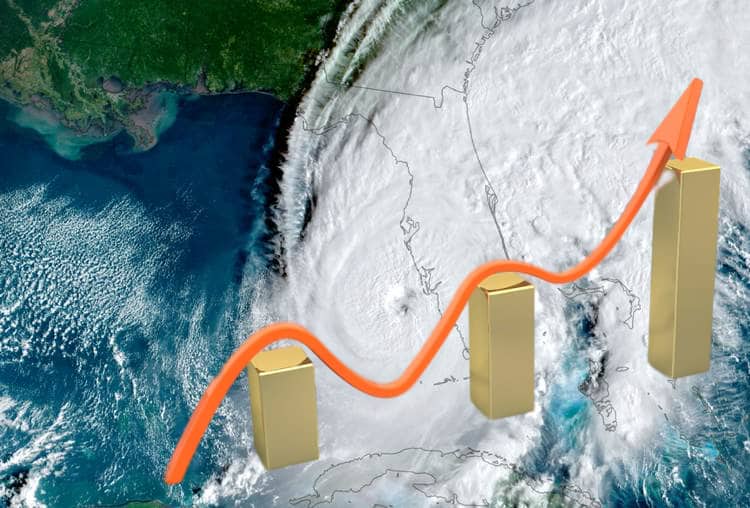Biggest cat bond price moves driven by biggest RMS V23 expected loss increases: Plenum

The catastrophe bonds that have seen the biggest price moves in recent weeks appear to be those that have seen their expected losses rise the most when remodelled using the RMS V23 update, according to Plenum Investments.
Plenum Investments, the Zurich-headquartered catastrophe bond specialist asset manager, has analysed the recent spread widening trend in catastrophe bonds and concluded that the updated view of risk from the Moody’s Insurance Solutions new V23 hurricane risk model is a significant driver of the movements seen.
We’ve already documented that the new risk model update has had an effect on spreads in recent weeks, being at least partially responsible for spread widening seen.
Plenum Investments was the first to report that at least a portion of the recent cat bond spread widening was being driven by the update to the hurricane model.
Then, investment manager Tenax Capital highlighted that the recent update of one of the main hurricane risk models used by insurance-linked securities (ILS) managers and investors had triggered a wave of selling in the catastrophe bond market.
Now, Plenum has provided some more insight into the way the model update has moved the cat bond market, highlighting that the cat bonds with the biggest price movements during this period of spread widening are also those that have the largest increase to their expected loss metrics under the RMS V23 risk model.
Dirk Schmelzer, Head Portfolio Manager ILS/CAT Bonds and Partner at Plenum Investments AG, discussed the spread widening trend being seen in the catastrophe bond market and connects it to the movement seen in industry-loss trigger cat bonds, in particular those with significant moves in risk metrics under the new RMS risk model.
“We observed that some cat bonds seemed to drive that development more than others and we looked at the top 10 positions with the largest price change, so the price decreases of course mean spread increases, so these are the positions that had the strongest change in prices,” Schmelzer said. “We looked at the change in risk modelling results for these bonds and what trigger type they comprise.”
He continued, “Two things stick out, so most of the transactions, 9 out of 10 are part of the PCS index trigger family and these bonds seem to have seen the most significant changes from version updates here to RMS, the natural catastrophe responding suite that we use internally, from version 21 to version 23.”
Plenum said there is a relation between the price decrease observed in April/May and the release of RMS’ new hurricane model.
Saying that the cat bonds with the biggest price increase, are the ones with the biggest expected loss increase under V23.
The expected loss increases are quite significant as well, so it is no surprise that the price has responded as a result, given these are signals of investor appetite to continue holding a cat bond and how much the market wants to get paid to do so.
When the view of risk is updated, which is an entirely necessary and important process, the cat bond and broader ILS market responds with an updated risk appetite, which can have the effect of raising, or lowering, the cost of capital somewhat.
These effects will also be playing out in the traditional insurance and reinsurance markets, where risk model updates of this kind are just as important and can be just as influential on the market’s pricing and rates-on-line.
Schmelzer summarised about the recent pricing dynamics in the cat bond market, “We see that we have two factors obviously driving that spread increase, the one is supply-demand dynamics,.
“But, it also shows that index-triggered bonds had significant risk changes, or how the market might look at that risk, and these bonds have the biggest price changes and therefore are driving that spread increase.”
Plenum’s analysis shows that, for some cat bonds, expected loss metrics can increase by more than half when modelled under RMS V23, instead of V21 of the hurricane risk model.
All of the top-10 catastrophe bonds that saw their prices move the most in April and May have seen an expected loss increase of at least 21%, the majority more than 50%.
The biggest expected loss movement was 60.17% for one cat bond, which saw its price move -5.17%.
But the biggest price mover shifted by -10.22%, although its expected loss only rose 54.37% under the RMS V23 model.
These are significant moves in risk metric, but it’s important to note that most ILS fund managers and investors try to use multiple models and also weight their models for factors they care about, such as sea surface temperature etc.
Plenum explained that the RMS model has changed in a number of ways and has updated hurricane frequency data in its catlaogue, updated hazard and vulnerability components, and an updated industry exposure database.
For the entire USA, Plenum noted that the expected loss has risen from around 5% to 10% with the model update. But in some regions the change is far higher.
In Florida, the modelled expected loss change is only 1%, from 5% to 6%. But in Texas it has risen from about 7% to 15%, in the Gulf Coast from 12% to 19%, and for the Southeast US from 4% to around 19%.
On average, across the entire US, modelled losses are up between 10% to 25% using the new model, depending on region, line of business and the set of frequencies used, Plenum explained.
The increase is larger for commercial lines than for residential, which could explain some of the focus on industry-loss trigger cat bonds, given they can cover multiple lines.
Notably, Plenum said that the biggest driver of the changes within the model itself is the vulnerability component update, which describes how buildings react to different types of wind speeds.
Overall, some 86% of US catastrophe bonds have a higher expected loss under RMS V23 than the previous version, Plenum said.
Over 90% of industry loss cat bonds have a large increase in their expected loss under the new risk model version, while just 9.84% of indemnity cat bonds face large EL increases as these are more focused on residential risks, than commercial.
The increase in expected loss across the index-trigger cat bond segment of the market tends to range from 40% to 65%, on average, Plenum noted.
Interestingly, Plenum states that in the RMS V21 model index-trigger cat bonds looked relatively more attractive, but under RMS V23 the reverse is true, as indemnity cat bonds now have the higher risk-adjusted returns.
For catastrophe bond and ILS fund managers, running the new RMS hurricane model against their portfolios will result in higher expected loss metrics, in almost all cases it seems.
Plenum noted that its lower-risk Plenum CAT Bond Defensive Fund sees its expected loss rise by 20.5% under the new model, while its strategy that targets a market-average type of return, the Plenum CAT Bond Dynamic Fund, sees its expected loss rise by 25.71%.
Plenum itself underweights the index-trigger catastrophe bond universe within its portfolios, so the effect is not as dramatic as it might be for some others.
Of course, there’s nothing wrong with updated views of risk, which help to ensure the industry is working off the latest science and understanding of natural catastrophe perils.
But the immediate effect of a model update can be significant and in this case has certainly raised the cost-of-capital for cat bond funds and investors, as evidenced by their demand for higher returns on the cat bonds that saw the biggest expected loss increases, which has also been translated across into the primary cat bond issuance market where new index-trigger bonds have seen their prices rise the most above guidance as well.






